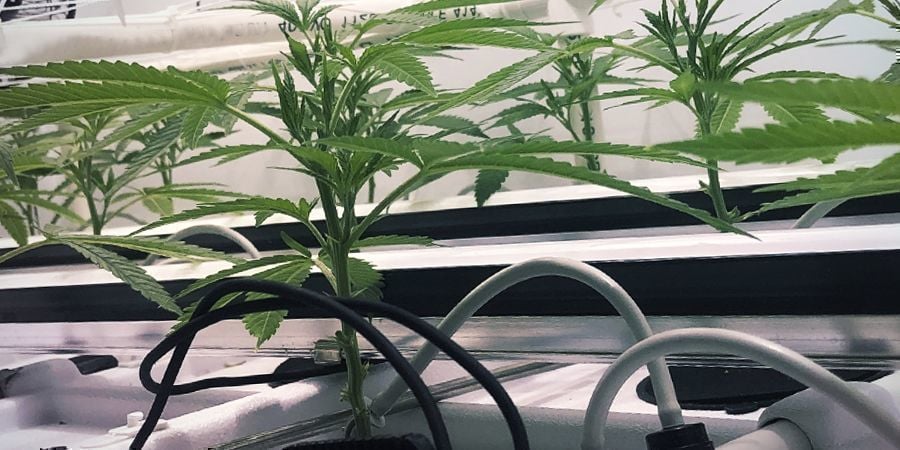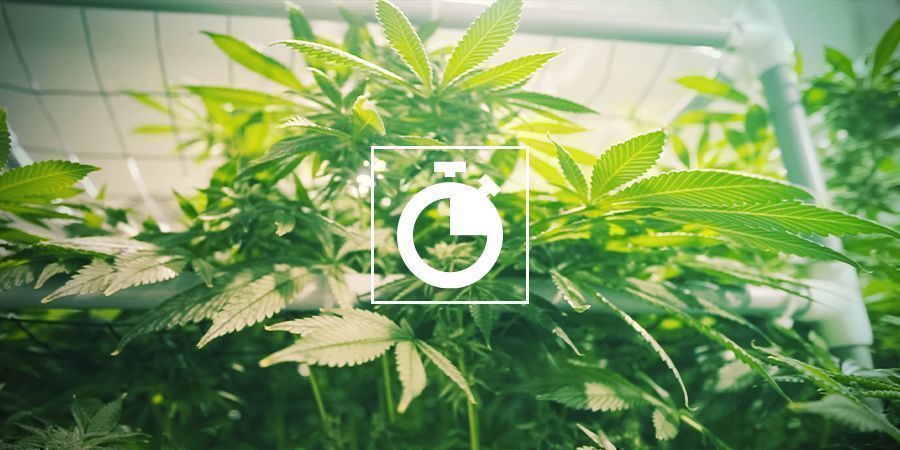The Different Types Of Hydroponic Systems For Growing Cannabis

Hydroponics offers growers big yields and fast results. Some methods are simple and cheap, whereas others are much more intricate and advanced. Check out the six most popular hydro methods below.
Hydroponic cultivation uses water as the main growing medium. Cannabis plants are often suspended above a nutrient-dense water source in a basket loaded with clay pellets or rockwool. As the roots develop, they grow down into the solution below.
Hydroponic growing offers a host of advantages compared to traditional cultivation in soil. Plants find it incredibly easy to absorb nutrients floating around in the solution, which helps them grow faster and more vigorously. Therefore, hydro plants tend to produce better yields in smaller windows of time.
Below, we’ll take a look at six of the most popular techniques used in hydroponic cannabis cultivation. We’ll check out how they work and the pros and cons of each.
1. DEEP WATER CULTURE (DWC)
As one of the most popular hydro methods, DWC provides an easy and effective means of growing dank buds. In this setup, plants sit above a reservoir in plastic baskets. All kinds of containers will do the job, but totes and buckets are the cheapest options.
Growers drill holes into the lids on these containers, big enough so the basket can fit comfortably without falling through. They then transfer seedlings into the baskets and surround their root balls with clay pebbles to keep them secure. As plants grow, the roots make their way down into the reservoir below. Growers keep the water topped up with mineral nutrients to fulfil the nutritional demands of their plants.
DWC setups also feature airstones in the reservoir. These devices pump oxygen into the water to ensure the roots continue to breathe, despite being submerged. The presence of oxygen also stops anaerobic bacteria from running rampant and rotting roots.
Pros:
• Easy to set up
• Relatively cheap
• Plants grow fast
• Can be easily automated
Cons:
• Subject to pH fluctuations
• Automated setups can be expensive in terms of electricity
• Roots can suffocate if pumps fail
2. EBB AND FLOW (FLOOD AND DRAIN)

In ebb and flow setups, growers position plants over a container like in the DWC model, except this time the vessel is periodically empty. The container is rigged over a tank of water filled with a nutrient solution. A pump connects the two chambers and periodically fills the plant container with water. The system floods and submerges the roots in the nutrient solution where they feed on minerals and drink up fluid.
Eventually, the pump turns off, and the solution drains back into the external tank, allowing the roots to breathe and dry out for extended periods.
Pros:
• Plants have adequate periods to feed and breathe
• No noisy pumps
• Can be stacked and takes up little space
• Can be completely automated
Cons:
• Automation can take a toll on electricity bills
• Crops can be ruined if the system fails
• Needs frequent cleaning to prevent root diseases
3. WICKING

As the most simple method, wick systems bring hydroponics back to basics. Wicking uses no airstones and no pumps. Instead, the method relies on capillary action that works against gravity—simple materials such as nylon rope and cloth work to pull water upwards in this fashion.
Plants sit in a basket on top of a container filled with nutrient solution. The roots grow down into the container but don’t make contact with the water. Instead, a wick bridges the gap between the root system and the solution, creating a passive system. Plants will drink water from the wick system when they need it.
Pros:
• Impossible to overwater
• Roots can breathe well
• Low-tech and silent
• Ideal for beginners
Cons:
• Not compatible with large, thirsty plants
• Prone to mould
4. DRIP

Drip hydroponic systems use a form of irrigation that slowly drips nutrient solution over the root system. Plants sit suspended in a grow tray filled with an inert medium such as coco coir. The tray sits above an external water tank that houses the nutrient solution and an airstone. A pump forces the solution through a drip irrigation system, providing a constant but slow supply of nutrients and water.
Gravity pulls the solution through the growing medium, over plant roots, and drains any excess through a pipe and back into the external water tank.
Pros:
• Extremely economical and saves water
• Easy to automate
• Suitable for beginners
• Ideal for hot and arid climates
Cons:
• Irrigation system can become clogged
• Automation can become expensive
• Pump and airstone generate noise
5. AEROPONICS
Aeroponic systems feed and water the roots using a fine aerosolised mist, as opposed to a flow or reservoir of water. These systems feature a planter and a water tank. Plants sit over the planter in baskets, and growers place a collar over the top of each basket to prevent the fine mist from evaporating out.
A series of nozzles attach to the sides of the planter bed. Numerous pipes deliver a nutrient solution from an external tank to the nozzles, which spray it out towards the plant roots as a fine mist. Excess water drips to the bottom of the planter and drains back into the water tank.
Pros:
• Provides good aeration
• Saves water
• Rapid nutrient absorption
Cons:
• Requires close attention
• Advanced technique
• Requires automation to run smoothly
• Prone to mould
6. NUTRIENT FILM TECHNIQUE (NFT)

NFT constantly submerges roots in a running stream of nutrient solution. The method shares traits with ebb and flow, but the roots receive a constant supply of water.
NFT suspends plants on a tray that features a small slope on the bottom surface. Pumps force the nutrient solution into the plant tray at the top of the slope, and gravity directs the water down towards a drainage pipe at the other end of the tray, sending it back into the reservoir. The running water supplies the roots with nutrients and oxygen at the same time.
Pros:
• Uses little water
• Oxygenates the roots
• Simple to set up and run
Cons:
• Plants won’t receive nutrients if the pump fails or breaks
SUMMARY

Hydroponics allows growers to achieve impressive results in a short space of time. Although these methods might seem detached from nature, they do the Earth a world of good. They do consume quite a bit of energy, but they end up saving much more water than indoor and outdoor grows that use soil.
The six methods above represent some of the most popular techniques. There are several variations on each method, as well as many more techniques out there to be explored.














 United States
United States












